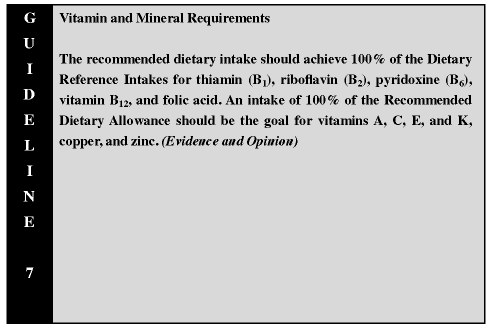

Vitamins and minerals are essential for normal growth and development. Studies conducted in the adult dialysis population have provided evidence of low blood concentrations of water-soluble vitamins and minerals because of inadequate intake, increased losses, and increased needs.46-48
The Dietary Reference Intakes (DRIs) for a number of nutrients have recently replaced the RDAs and are based on four sources: the RDA, the Tolerable Upper Intake Level, the Estimated Average Requirement, and the Adequate Intake.49 DRIs are reference values that are quantitative estimates of nutrient intakes used for planning and assessing diets for healthy individuals. It has been proposed that the RDA and average intake may each serve as a further basis for adjusting individual recommendations for patients with special health care needs.48 In the case of nutrients for which DRIs are not yet developed, the previously published RDAs remain the standard.33
No published studies have assessed the blood vitamin levels of children undergoing maintenance peritoneal dialysis or HD in the absence of the use of a vitamin supplement. Therefore, recent practice has been to routinely provide a water-soluble vitamin supplement to children receiving dialysis. Whereas dietary intakes below the DRI have been documented for vitamins B6 and B2, the needs for the other water-soluble vitamins are regularly met by dietary intake alone. Consequently, the combination of dietary and supplemental vitamin intake is routinely associated with blood concentrations that meet or exceed normal values.50-52
Accordingly, it is recommended that an intake of 100% of the DRI is a reasonable starting point for water-soluble vitamin requirements in children on MD (Table 4). It is also recommended that the nutritional status of water-soluble vitamin be monitored. Supplementation should be considered if the dietary intake alone does not meet or exceed the DRI, if measured blood vitamin levels are below normal values, or if clinical evidence of deficiency is present (eg, low folic acid or vitamin B12 levels giving rise to poor responsiveness to recombinant human erythropoietin).

The blood levels of fat-soluble vitamins A and E are normal or elevated in pediatric patients receiving dialysis despite the lack of excessive dietary intake or vitamin supplementation (Table 5). The loss of clearance of vitamin A metabolites by the normal kidney places dialysis patients at risk for symptoms of hypervitaminosis A. This is an important consideration when selecting a multivitamin that contains a combination of water- and fat-soluble vitamins. Limited data are available on the status of vitamin K in the ESRD population, although it is possible that a child's vitamin K status could be compromised by a poor dietary vitamin K intake, particularly during antibiotic therapy, which suppresses intestinal bacteria that synthesize vitamin K.53

A dietary intake below the RDA has been noted for zinc and copper in children receiving peritoneal dialysis.50 It is recommended that the intake of these minerals be monitored every 4 to 6 months, because supplementation may be required in patients whose dietary intake is particularly low, for those undergoing MD for prolonged periods of time, or for those who demonstrate laboratory or clinical evidence of trace metal deficiency.34